Therapeutic Relationships: A Case Study in Nursing Practice (NUR1202)
VerifiedAdded on 2023/06/07
|11
|2845
|306
Case Study
AI Summary
This case study assignment analyzes a nursing scenario focusing on the importance of therapeutic relationships, ethical considerations, and cultural sensitivity. The essay explores the components of a therapeutic relationship, including trust, respect, and empathy, and examines how these elements contribute to positive patient-nurse interactions. The assignment references the NMBA Code of Conduct and Registered Nurse Standards for Practice to support the concepts of therapeutic relationships, informed decision-making, and cultural safety. The case study highlights the impact of paternalism, the need for informed consent, and the importance of culturally competent care, especially when interacting with patients from diverse backgrounds, such as Aboriginal women. The analysis also discusses the implications of power imbalances and the necessity of respecting patient autonomy and dignity in clinical practice. The assignment emphasizes the importance of establishing trust, using nonverbal communication, and obtaining consent before any physical examination to ensure patient well-being and adherence to ethical standards.
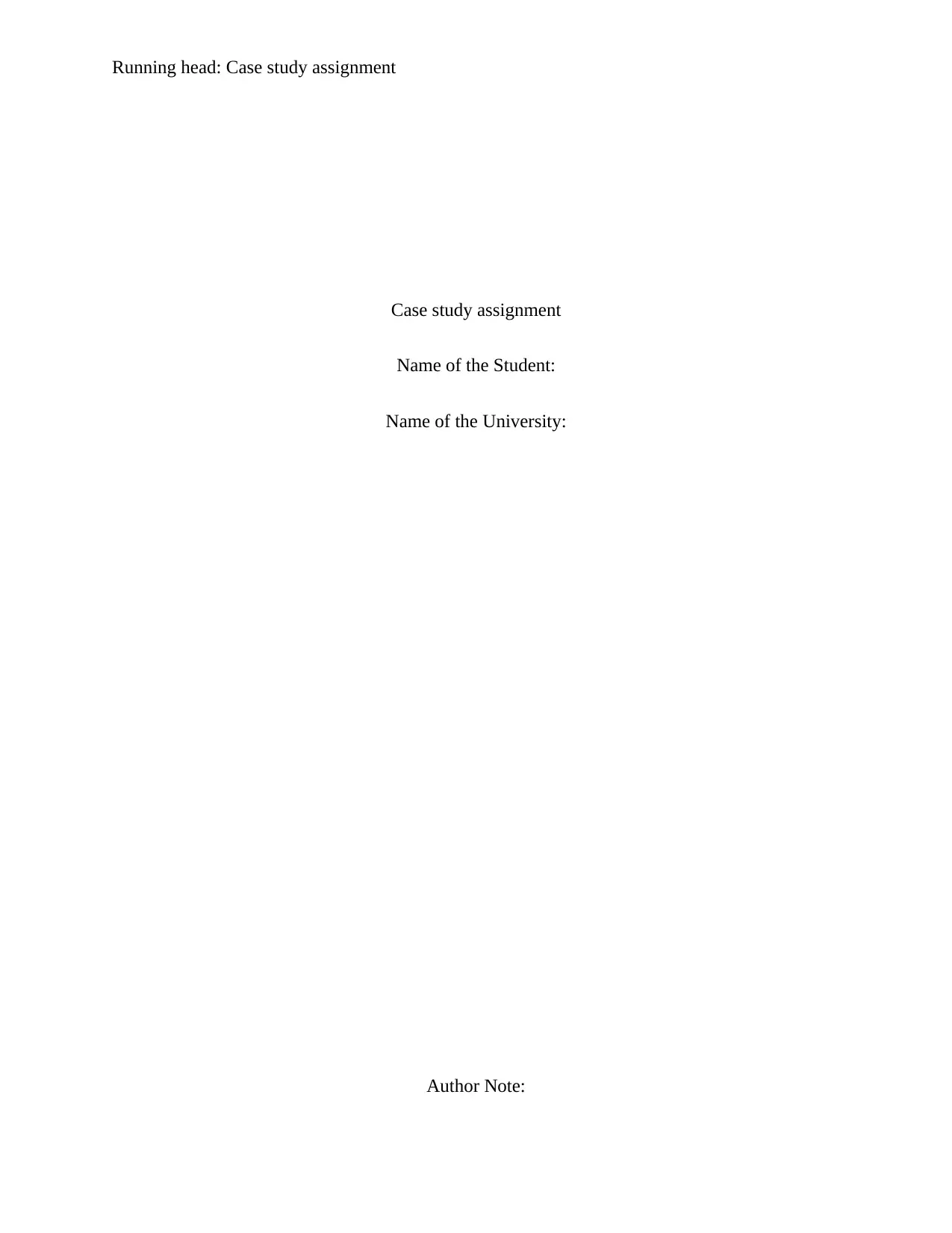
Running head: Case study assignment
Case study assignment
Name of the Student:
Name of the University:
Author Note:
Case study assignment
Name of the Student:
Name of the University:
Author Note:
Paraphrase This Document
Need a fresh take? Get an instant paraphrase of this document with our AI Paraphraser
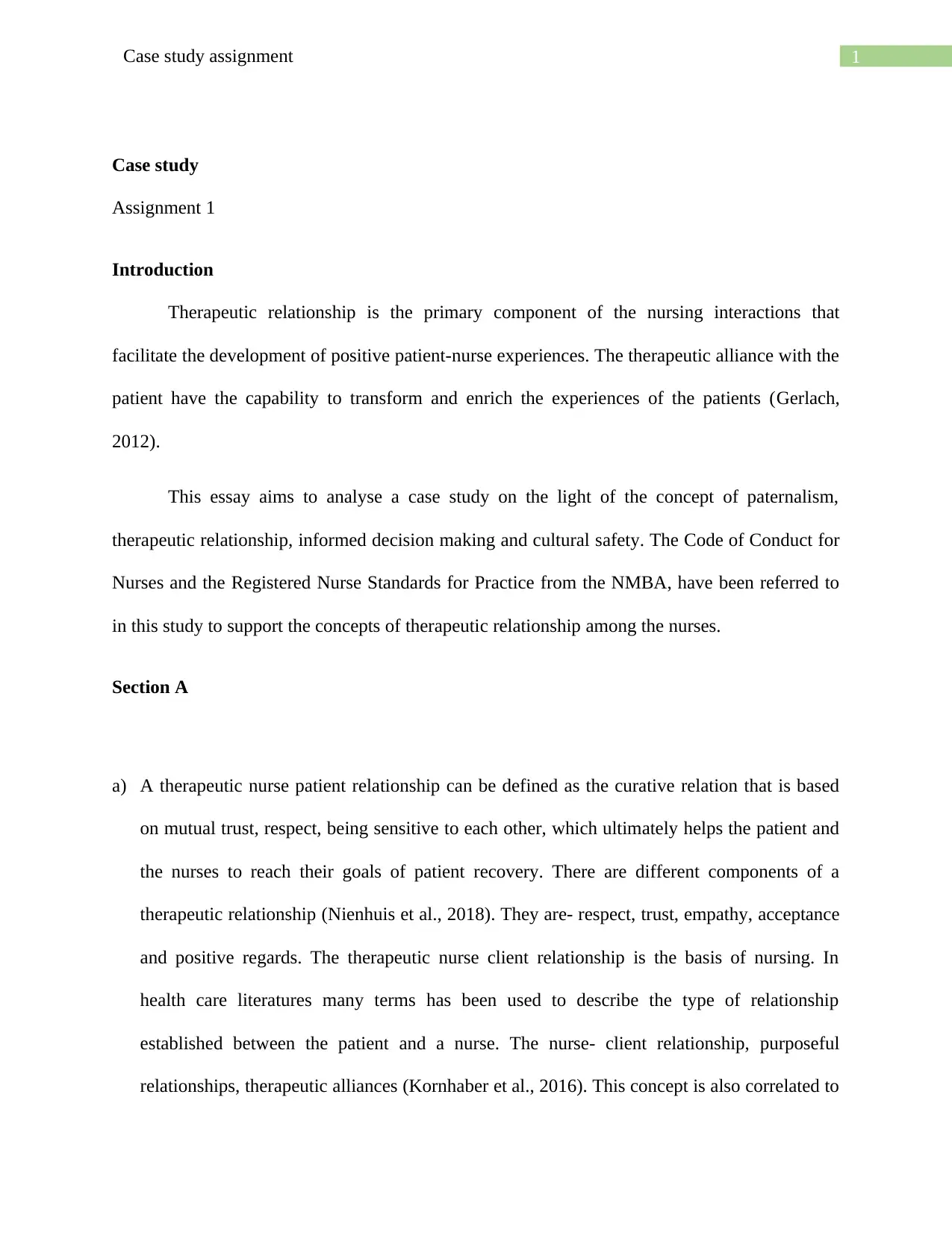
1Case study assignment
Case study
Assignment 1
Introduction
Therapeutic relationship is the primary component of the nursing interactions that
facilitate the development of positive patient-nurse experiences. The therapeutic alliance with the
patient have the capability to transform and enrich the experiences of the patients (Gerlach,
2012).
This essay aims to analyse a case study on the light of the concept of paternalism,
therapeutic relationship, informed decision making and cultural safety. The Code of Conduct for
Nurses and the Registered Nurse Standards for Practice from the NMBA, have been referred to
in this study to support the concepts of therapeutic relationship among the nurses.
Section A
a) A therapeutic nurse patient relationship can be defined as the curative relation that is based
on mutual trust, respect, being sensitive to each other, which ultimately helps the patient and
the nurses to reach their goals of patient recovery. There are different components of a
therapeutic relationship (Nienhuis et al., 2018). They are- respect, trust, empathy, acceptance
and positive regards. The therapeutic nurse client relationship is the basis of nursing. In
health care literatures many terms has been used to describe the type of relationship
established between the patient and a nurse. The nurse- client relationship, purposeful
relationships, therapeutic alliances (Kornhaber et al., 2016). This concept is also correlated to
Case study
Assignment 1
Introduction
Therapeutic relationship is the primary component of the nursing interactions that
facilitate the development of positive patient-nurse experiences. The therapeutic alliance with the
patient have the capability to transform and enrich the experiences of the patients (Gerlach,
2012).
This essay aims to analyse a case study on the light of the concept of paternalism,
therapeutic relationship, informed decision making and cultural safety. The Code of Conduct for
Nurses and the Registered Nurse Standards for Practice from the NMBA, have been referred to
in this study to support the concepts of therapeutic relationship among the nurses.
Section A
a) A therapeutic nurse patient relationship can be defined as the curative relation that is based
on mutual trust, respect, being sensitive to each other, which ultimately helps the patient and
the nurses to reach their goals of patient recovery. There are different components of a
therapeutic relationship (Nienhuis et al., 2018). They are- respect, trust, empathy, acceptance
and positive regards. The therapeutic nurse client relationship is the basis of nursing. In
health care literatures many terms has been used to describe the type of relationship
established between the patient and a nurse. The nurse- client relationship, purposeful
relationships, therapeutic alliances (Kornhaber et al., 2016). This concept is also correlated to
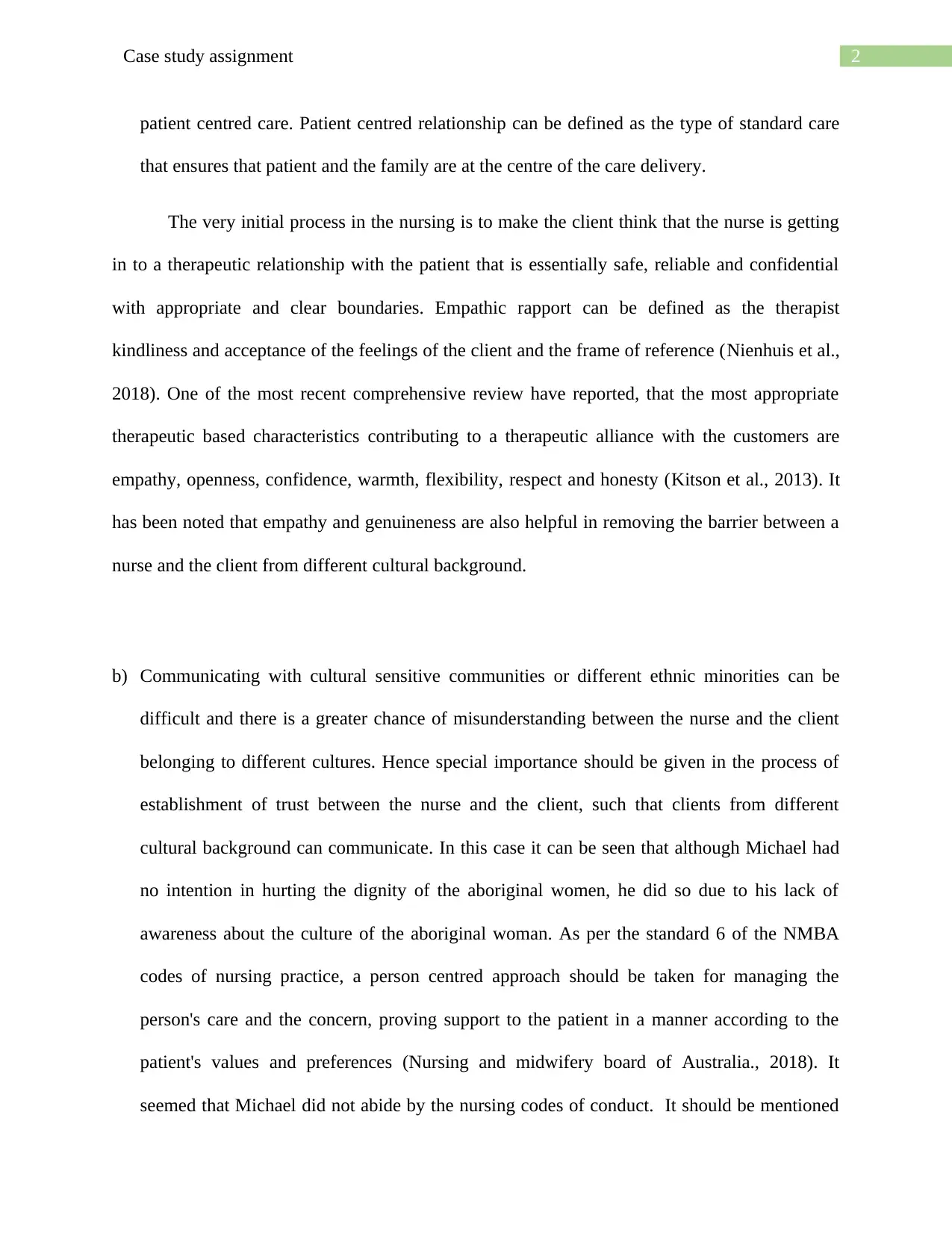
2Case study assignment
patient centred care. Patient centred relationship can be defined as the type of standard care
that ensures that patient and the family are at the centre of the care delivery.
The very initial process in the nursing is to make the client think that the nurse is getting
in to a therapeutic relationship with the patient that is essentially safe, reliable and confidential
with appropriate and clear boundaries. Empathic rapport can be defined as the therapist
kindliness and acceptance of the feelings of the client and the frame of reference (Nienhuis et al.,
2018). One of the most recent comprehensive review have reported, that the most appropriate
therapeutic based characteristics contributing to a therapeutic alliance with the customers are
empathy, openness, confidence, warmth, flexibility, respect and honesty (Kitson et al., 2013). It
has been noted that empathy and genuineness are also helpful in removing the barrier between a
nurse and the client from different cultural background.
b) Communicating with cultural sensitive communities or different ethnic minorities can be
difficult and there is a greater chance of misunderstanding between the nurse and the client
belonging to different cultures. Hence special importance should be given in the process of
establishment of trust between the nurse and the client, such that clients from different
cultural background can communicate. In this case it can be seen that although Michael had
no intention in hurting the dignity of the aboriginal women, he did so due to his lack of
awareness about the culture of the aboriginal woman. As per the standard 6 of the NMBA
codes of nursing practice, a person centred approach should be taken for managing the
person's care and the concern, proving support to the patient in a manner according to the
patient's values and preferences (Nursing and midwifery board of Australia., 2018). It
seemed that Michael did not abide by the nursing codes of conduct. It should be mentioned
patient centred care. Patient centred relationship can be defined as the type of standard care
that ensures that patient and the family are at the centre of the care delivery.
The very initial process in the nursing is to make the client think that the nurse is getting
in to a therapeutic relationship with the patient that is essentially safe, reliable and confidential
with appropriate and clear boundaries. Empathic rapport can be defined as the therapist
kindliness and acceptance of the feelings of the client and the frame of reference (Nienhuis et al.,
2018). One of the most recent comprehensive review have reported, that the most appropriate
therapeutic based characteristics contributing to a therapeutic alliance with the customers are
empathy, openness, confidence, warmth, flexibility, respect and honesty (Kitson et al., 2013). It
has been noted that empathy and genuineness are also helpful in removing the barrier between a
nurse and the client from different cultural background.
b) Communicating with cultural sensitive communities or different ethnic minorities can be
difficult and there is a greater chance of misunderstanding between the nurse and the client
belonging to different cultures. Hence special importance should be given in the process of
establishment of trust between the nurse and the client, such that clients from different
cultural background can communicate. In this case it can be seen that although Michael had
no intention in hurting the dignity of the aboriginal women, he did so due to his lack of
awareness about the culture of the aboriginal woman. As per the standard 6 of the NMBA
codes of nursing practice, a person centred approach should be taken for managing the
person's care and the concern, proving support to the patient in a manner according to the
patient's values and preferences (Nursing and midwifery board of Australia., 2018). It
seemed that Michael did not abide by the nursing codes of conduct. It should be mentioned
⊘ This is a preview!⊘
Do you want full access?
Subscribe today to unlock all pages.

Trusted by 1+ million students worldwide
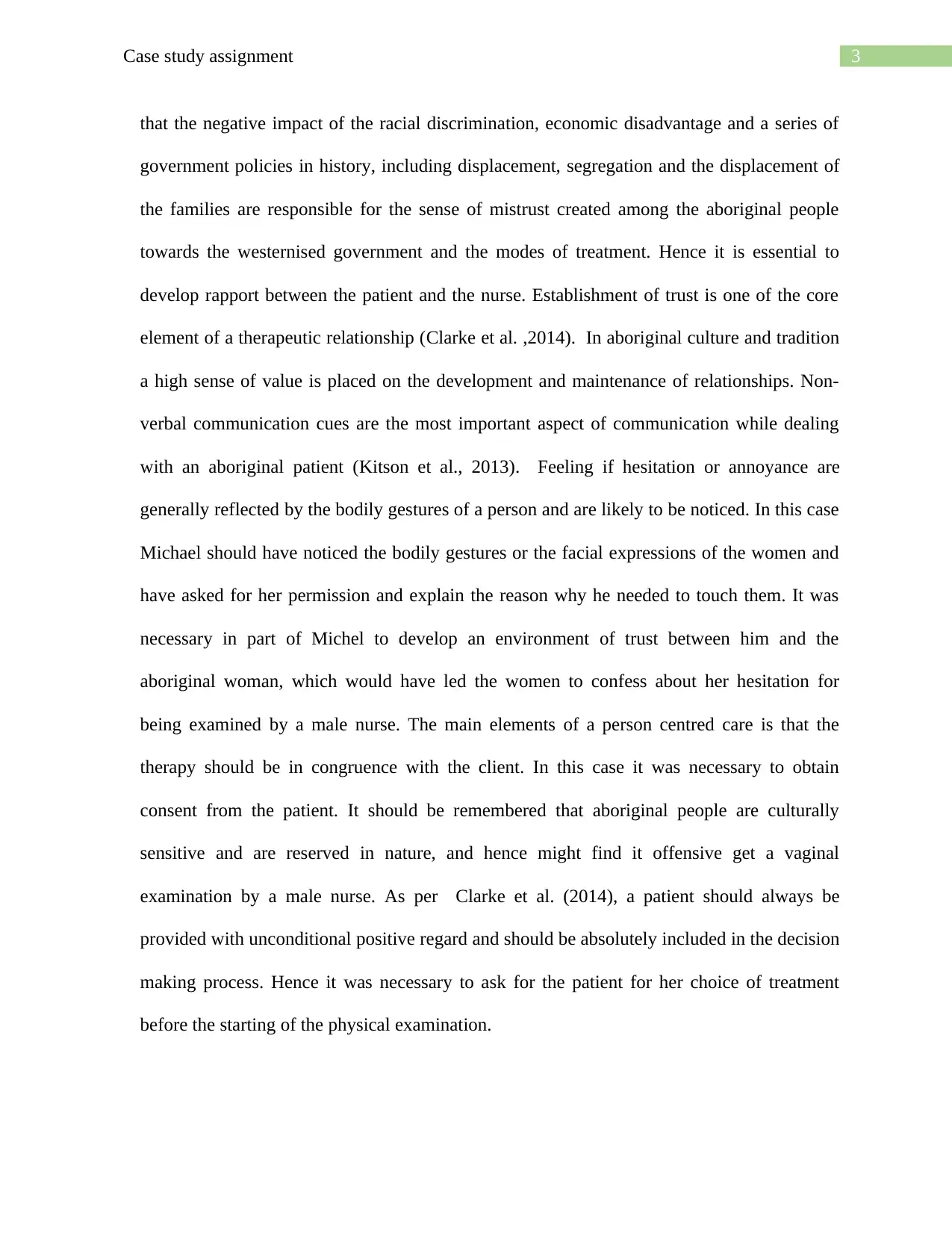
3Case study assignment
that the negative impact of the racial discrimination, economic disadvantage and a series of
government policies in history, including displacement, segregation and the displacement of
the families are responsible for the sense of mistrust created among the aboriginal people
towards the westernised government and the modes of treatment. Hence it is essential to
develop rapport between the patient and the nurse. Establishment of trust is one of the core
element of a therapeutic relationship (Clarke et al. ,2014). In aboriginal culture and tradition
a high sense of value is placed on the development and maintenance of relationships. Non-
verbal communication cues are the most important aspect of communication while dealing
with an aboriginal patient (Kitson et al., 2013). Feeling if hesitation or annoyance are
generally reflected by the bodily gestures of a person and are likely to be noticed. In this case
Michael should have noticed the bodily gestures or the facial expressions of the women and
have asked for her permission and explain the reason why he needed to touch them. It was
necessary in part of Michel to develop an environment of trust between him and the
aboriginal woman, which would have led the women to confess about her hesitation for
being examined by a male nurse. The main elements of a person centred care is that the
therapy should be in congruence with the client. In this case it was necessary to obtain
consent from the patient. It should be remembered that aboriginal people are culturally
sensitive and are reserved in nature, and hence might find it offensive get a vaginal
examination by a male nurse. As per Clarke et al. (2014), a patient should always be
provided with unconditional positive regard and should be absolutely included in the decision
making process. Hence it was necessary to ask for the patient for her choice of treatment
before the starting of the physical examination.
that the negative impact of the racial discrimination, economic disadvantage and a series of
government policies in history, including displacement, segregation and the displacement of
the families are responsible for the sense of mistrust created among the aboriginal people
towards the westernised government and the modes of treatment. Hence it is essential to
develop rapport between the patient and the nurse. Establishment of trust is one of the core
element of a therapeutic relationship (Clarke et al. ,2014). In aboriginal culture and tradition
a high sense of value is placed on the development and maintenance of relationships. Non-
verbal communication cues are the most important aspect of communication while dealing
with an aboriginal patient (Kitson et al., 2013). Feeling if hesitation or annoyance are
generally reflected by the bodily gestures of a person and are likely to be noticed. In this case
Michael should have noticed the bodily gestures or the facial expressions of the women and
have asked for her permission and explain the reason why he needed to touch them. It was
necessary in part of Michel to develop an environment of trust between him and the
aboriginal woman, which would have led the women to confess about her hesitation for
being examined by a male nurse. The main elements of a person centred care is that the
therapy should be in congruence with the client. In this case it was necessary to obtain
consent from the patient. It should be remembered that aboriginal people are culturally
sensitive and are reserved in nature, and hence might find it offensive get a vaginal
examination by a male nurse. As per Clarke et al. (2014), a patient should always be
provided with unconditional positive regard and should be absolutely included in the decision
making process. Hence it was necessary to ask for the patient for her choice of treatment
before the starting of the physical examination.
Paraphrase This Document
Need a fresh take? Get an instant paraphrase of this document with our AI Paraphraser
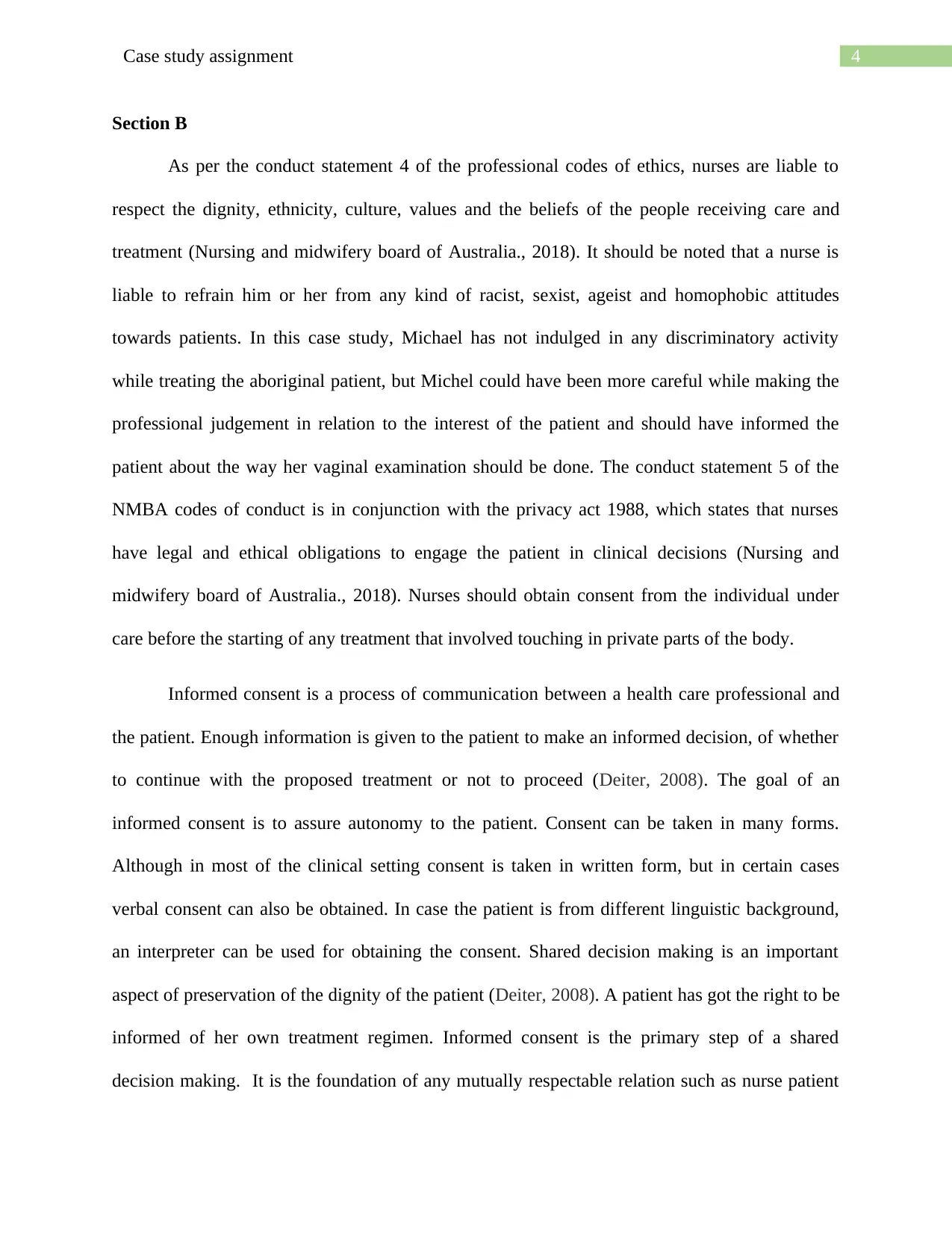
4Case study assignment
Section B
As per the conduct statement 4 of the professional codes of ethics, nurses are liable to
respect the dignity, ethnicity, culture, values and the beliefs of the people receiving care and
treatment (Nursing and midwifery board of Australia., 2018). It should be noted that a nurse is
liable to refrain him or her from any kind of racist, sexist, ageist and homophobic attitudes
towards patients. In this case study, Michael has not indulged in any discriminatory activity
while treating the aboriginal patient, but Michel could have been more careful while making the
professional judgement in relation to the interest of the patient and should have informed the
patient about the way her vaginal examination should be done. The conduct statement 5 of the
NMBA codes of conduct is in conjunction with the privacy act 1988, which states that nurses
have legal and ethical obligations to engage the patient in clinical decisions (Nursing and
midwifery board of Australia., 2018). Nurses should obtain consent from the individual under
care before the starting of any treatment that involved touching in private parts of the body.
Informed consent is a process of communication between a health care professional and
the patient. Enough information is given to the patient to make an informed decision, of whether
to continue with the proposed treatment or not to proceed (Deiter, 2008). The goal of an
informed consent is to assure autonomy to the patient. Consent can be taken in many forms.
Although in most of the clinical setting consent is taken in written form, but in certain cases
verbal consent can also be obtained. In case the patient is from different linguistic background,
an interpreter can be used for obtaining the consent. Shared decision making is an important
aspect of preservation of the dignity of the patient (Deiter, 2008). A patient has got the right to be
informed of her own treatment regimen. Informed consent is the primary step of a shared
decision making. It is the foundation of any mutually respectable relation such as nurse patient
Section B
As per the conduct statement 4 of the professional codes of ethics, nurses are liable to
respect the dignity, ethnicity, culture, values and the beliefs of the people receiving care and
treatment (Nursing and midwifery board of Australia., 2018). It should be noted that a nurse is
liable to refrain him or her from any kind of racist, sexist, ageist and homophobic attitudes
towards patients. In this case study, Michael has not indulged in any discriminatory activity
while treating the aboriginal patient, but Michel could have been more careful while making the
professional judgement in relation to the interest of the patient and should have informed the
patient about the way her vaginal examination should be done. The conduct statement 5 of the
NMBA codes of conduct is in conjunction with the privacy act 1988, which states that nurses
have legal and ethical obligations to engage the patient in clinical decisions (Nursing and
midwifery board of Australia., 2018). Nurses should obtain consent from the individual under
care before the starting of any treatment that involved touching in private parts of the body.
Informed consent is a process of communication between a health care professional and
the patient. Enough information is given to the patient to make an informed decision, of whether
to continue with the proposed treatment or not to proceed (Deiter, 2008). The goal of an
informed consent is to assure autonomy to the patient. Consent can be taken in many forms.
Although in most of the clinical setting consent is taken in written form, but in certain cases
verbal consent can also be obtained. In case the patient is from different linguistic background,
an interpreter can be used for obtaining the consent. Shared decision making is an important
aspect of preservation of the dignity of the patient (Deiter, 2008). A patient has got the right to be
informed of her own treatment regimen. Informed consent is the primary step of a shared
decision making. It is the foundation of any mutually respectable relation such as nurse patient
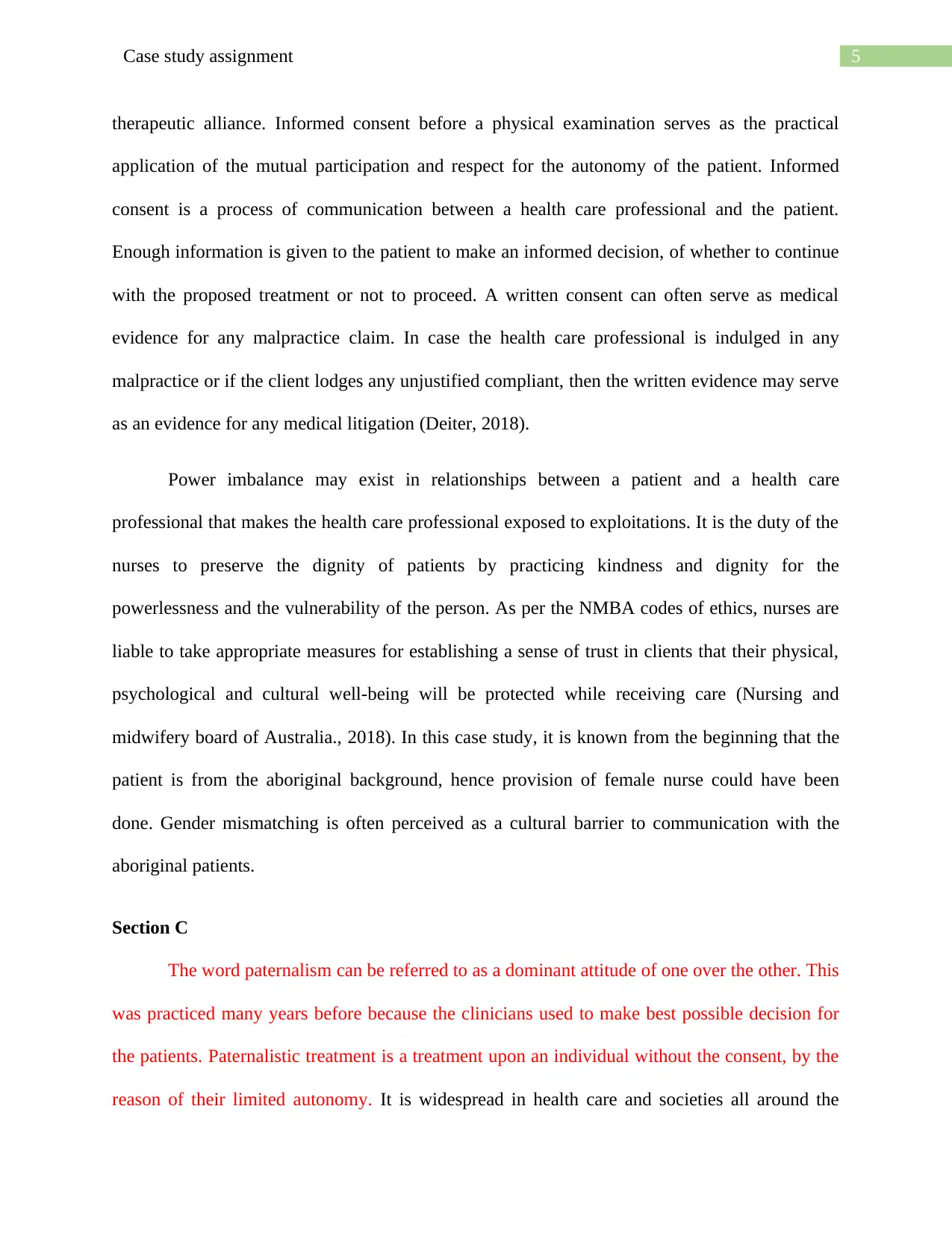
5Case study assignment
therapeutic alliance. Informed consent before a physical examination serves as the practical
application of the mutual participation and respect for the autonomy of the patient. Informed
consent is a process of communication between a health care professional and the patient.
Enough information is given to the patient to make an informed decision, of whether to continue
with the proposed treatment or not to proceed. A written consent can often serve as medical
evidence for any malpractice claim. In case the health care professional is indulged in any
malpractice or if the client lodges any unjustified compliant, then the written evidence may serve
as an evidence for any medical litigation (Deiter, 2018).
Power imbalance may exist in relationships between a patient and a health care
professional that makes the health care professional exposed to exploitations. It is the duty of the
nurses to preserve the dignity of patients by practicing kindness and dignity for the
powerlessness and the vulnerability of the person. As per the NMBA codes of ethics, nurses are
liable to take appropriate measures for establishing a sense of trust in clients that their physical,
psychological and cultural well-being will be protected while receiving care (Nursing and
midwifery board of Australia., 2018). In this case study, it is known from the beginning that the
patient is from the aboriginal background, hence provision of female nurse could have been
done. Gender mismatching is often perceived as a cultural barrier to communication with the
aboriginal patients.
Section C
The word paternalism can be referred to as a dominant attitude of one over the other. This
was practiced many years before because the clinicians used to make best possible decision for
the patients. Paternalistic treatment is a treatment upon an individual without the consent, by the
reason of their limited autonomy. It is widespread in health care and societies all around the
therapeutic alliance. Informed consent before a physical examination serves as the practical
application of the mutual participation and respect for the autonomy of the patient. Informed
consent is a process of communication between a health care professional and the patient.
Enough information is given to the patient to make an informed decision, of whether to continue
with the proposed treatment or not to proceed. A written consent can often serve as medical
evidence for any malpractice claim. In case the health care professional is indulged in any
malpractice or if the client lodges any unjustified compliant, then the written evidence may serve
as an evidence for any medical litigation (Deiter, 2018).
Power imbalance may exist in relationships between a patient and a health care
professional that makes the health care professional exposed to exploitations. It is the duty of the
nurses to preserve the dignity of patients by practicing kindness and dignity for the
powerlessness and the vulnerability of the person. As per the NMBA codes of ethics, nurses are
liable to take appropriate measures for establishing a sense of trust in clients that their physical,
psychological and cultural well-being will be protected while receiving care (Nursing and
midwifery board of Australia., 2018). In this case study, it is known from the beginning that the
patient is from the aboriginal background, hence provision of female nurse could have been
done. Gender mismatching is often perceived as a cultural barrier to communication with the
aboriginal patients.
Section C
The word paternalism can be referred to as a dominant attitude of one over the other. This
was practiced many years before because the clinicians used to make best possible decision for
the patients. Paternalistic treatment is a treatment upon an individual without the consent, by the
reason of their limited autonomy. It is widespread in health care and societies all around the
⊘ This is a preview!⊘
Do you want full access?
Subscribe today to unlock all pages.

Trusted by 1+ million students worldwide
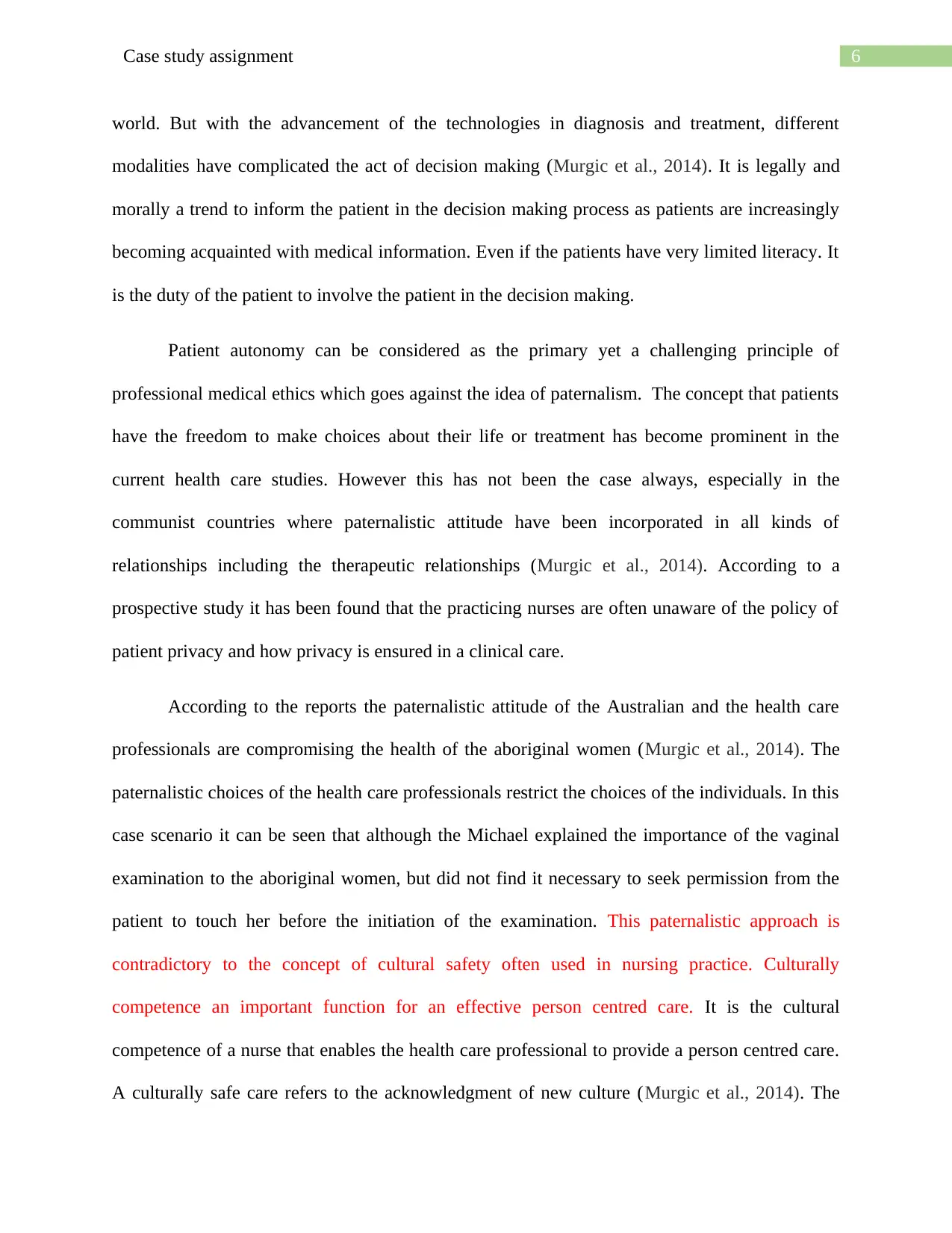
6Case study assignment
world. But with the advancement of the technologies in diagnosis and treatment, different
modalities have complicated the act of decision making (Murgic et al., 2014). It is legally and
morally a trend to inform the patient in the decision making process as patients are increasingly
becoming acquainted with medical information. Even if the patients have very limited literacy. It
is the duty of the patient to involve the patient in the decision making.
Patient autonomy can be considered as the primary yet a challenging principle of
professional medical ethics which goes against the idea of paternalism. The concept that patients
have the freedom to make choices about their life or treatment has become prominent in the
current health care studies. However this has not been the case always, especially in the
communist countries where paternalistic attitude have been incorporated in all kinds of
relationships including the therapeutic relationships (Murgic et al., 2014). According to a
prospective study it has been found that the practicing nurses are often unaware of the policy of
patient privacy and how privacy is ensured in a clinical care.
According to the reports the paternalistic attitude of the Australian and the health care
professionals are compromising the health of the aboriginal women (Murgic et al., 2014). The
paternalistic choices of the health care professionals restrict the choices of the individuals. In this
case scenario it can be seen that although the Michael explained the importance of the vaginal
examination to the aboriginal women, but did not find it necessary to seek permission from the
patient to touch her before the initiation of the examination. This paternalistic approach is
contradictory to the concept of cultural safety often used in nursing practice. Culturally
competence an important function for an effective person centred care. It is the cultural
competence of a nurse that enables the health care professional to provide a person centred care.
A culturally safe care refers to the acknowledgment of new culture (Murgic et al., 2014). The
world. But with the advancement of the technologies in diagnosis and treatment, different
modalities have complicated the act of decision making (Murgic et al., 2014). It is legally and
morally a trend to inform the patient in the decision making process as patients are increasingly
becoming acquainted with medical information. Even if the patients have very limited literacy. It
is the duty of the patient to involve the patient in the decision making.
Patient autonomy can be considered as the primary yet a challenging principle of
professional medical ethics which goes against the idea of paternalism. The concept that patients
have the freedom to make choices about their life or treatment has become prominent in the
current health care studies. However this has not been the case always, especially in the
communist countries where paternalistic attitude have been incorporated in all kinds of
relationships including the therapeutic relationships (Murgic et al., 2014). According to a
prospective study it has been found that the practicing nurses are often unaware of the policy of
patient privacy and how privacy is ensured in a clinical care.
According to the reports the paternalistic attitude of the Australian and the health care
professionals are compromising the health of the aboriginal women (Murgic et al., 2014). The
paternalistic choices of the health care professionals restrict the choices of the individuals. In this
case scenario it can be seen that although the Michael explained the importance of the vaginal
examination to the aboriginal women, but did not find it necessary to seek permission from the
patient to touch her before the initiation of the examination. This paternalistic approach is
contradictory to the concept of cultural safety often used in nursing practice. Culturally
competence an important function for an effective person centred care. It is the cultural
competence of a nurse that enables the health care professional to provide a person centred care.
A culturally safe care refers to the acknowledgment of new culture (Murgic et al., 2014). The
Paraphrase This Document
Need a fresh take? Get an instant paraphrase of this document with our AI Paraphraser
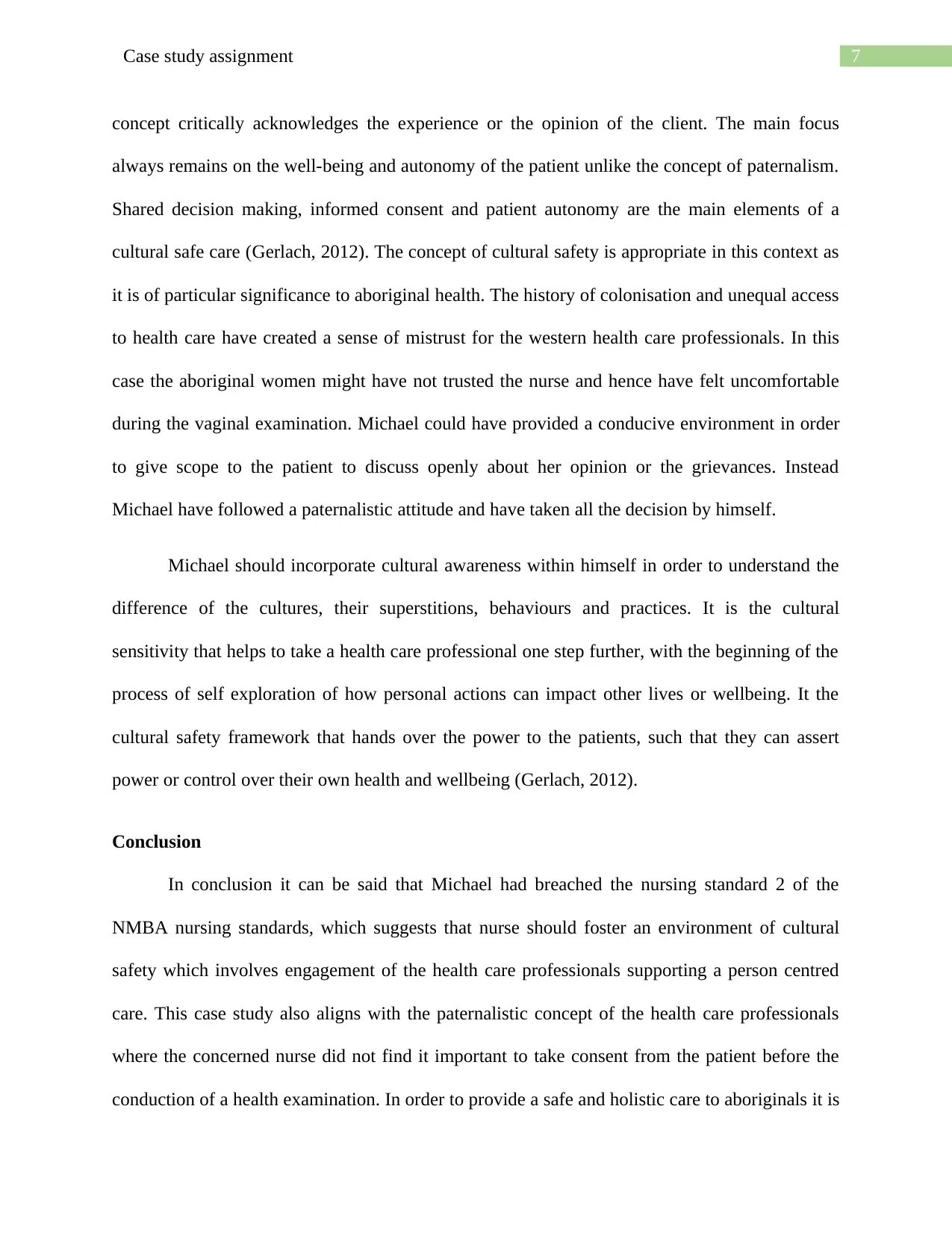
7Case study assignment
concept critically acknowledges the experience or the opinion of the client. The main focus
always remains on the well-being and autonomy of the patient unlike the concept of paternalism.
Shared decision making, informed consent and patient autonomy are the main elements of a
cultural safe care (Gerlach, 2012). The concept of cultural safety is appropriate in this context as
it is of particular significance to aboriginal health. The history of colonisation and unequal access
to health care have created a sense of mistrust for the western health care professionals. In this
case the aboriginal women might have not trusted the nurse and hence have felt uncomfortable
during the vaginal examination. Michael could have provided a conducive environment in order
to give scope to the patient to discuss openly about her opinion or the grievances. Instead
Michael have followed a paternalistic attitude and have taken all the decision by himself.
Michael should incorporate cultural awareness within himself in order to understand the
difference of the cultures, their superstitions, behaviours and practices. It is the cultural
sensitivity that helps to take a health care professional one step further, with the beginning of the
process of self exploration of how personal actions can impact other lives or wellbeing. It the
cultural safety framework that hands over the power to the patients, such that they can assert
power or control over their own health and wellbeing (Gerlach, 2012).
Conclusion
In conclusion it can be said that Michael had breached the nursing standard 2 of the
NMBA nursing standards, which suggests that nurse should foster an environment of cultural
safety which involves engagement of the health care professionals supporting a person centred
care. This case study also aligns with the paternalistic concept of the health care professionals
where the concerned nurse did not find it important to take consent from the patient before the
conduction of a health examination. In order to provide a safe and holistic care to aboriginals it is
concept critically acknowledges the experience or the opinion of the client. The main focus
always remains on the well-being and autonomy of the patient unlike the concept of paternalism.
Shared decision making, informed consent and patient autonomy are the main elements of a
cultural safe care (Gerlach, 2012). The concept of cultural safety is appropriate in this context as
it is of particular significance to aboriginal health. The history of colonisation and unequal access
to health care have created a sense of mistrust for the western health care professionals. In this
case the aboriginal women might have not trusted the nurse and hence have felt uncomfortable
during the vaginal examination. Michael could have provided a conducive environment in order
to give scope to the patient to discuss openly about her opinion or the grievances. Instead
Michael have followed a paternalistic attitude and have taken all the decision by himself.
Michael should incorporate cultural awareness within himself in order to understand the
difference of the cultures, their superstitions, behaviours and practices. It is the cultural
sensitivity that helps to take a health care professional one step further, with the beginning of the
process of self exploration of how personal actions can impact other lives or wellbeing. It the
cultural safety framework that hands over the power to the patients, such that they can assert
power or control over their own health and wellbeing (Gerlach, 2012).
Conclusion
In conclusion it can be said that Michael had breached the nursing standard 2 of the
NMBA nursing standards, which suggests that nurse should foster an environment of cultural
safety which involves engagement of the health care professionals supporting a person centred
care. This case study also aligns with the paternalistic concept of the health care professionals
where the concerned nurse did not find it important to take consent from the patient before the
conduction of a health examination. In order to provide a safe and holistic care to aboriginals it is

8Case study assignment
necessary to set aside the concept of paternalism and provide a culturally safe care to the patient
by involving them in the decision making process and respecting their basic rights.
necessary to set aside the concept of paternalism and provide a culturally safe care to the patient
by involving them in the decision making process and respecting their basic rights.
⊘ This is a preview!⊘
Do you want full access?
Subscribe today to unlock all pages.

Trusted by 1+ million students worldwide
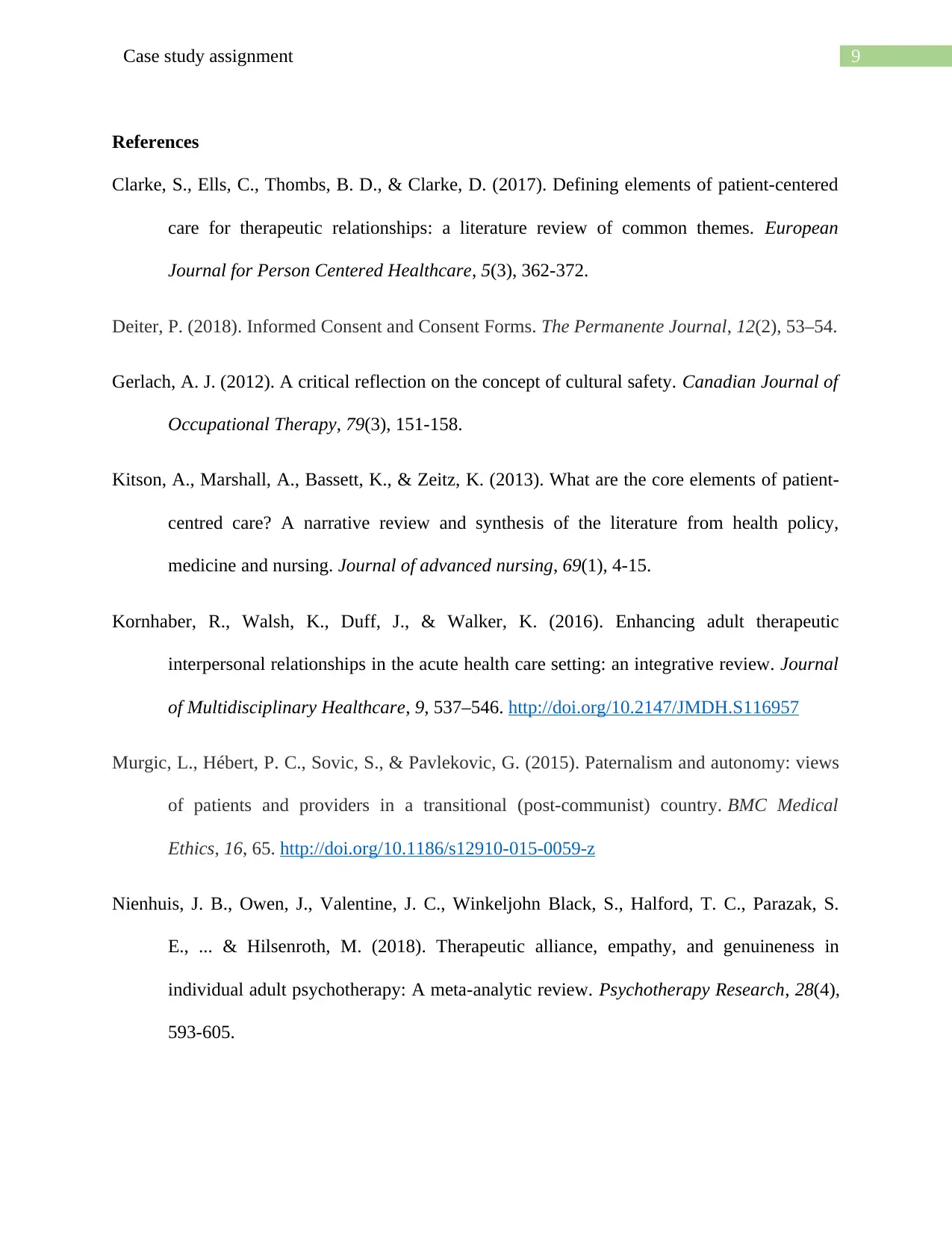
9Case study assignment
References
Clarke, S., Ells, C., Thombs, B. D., & Clarke, D. (2017). Defining elements of patient-centered
care for therapeutic relationships: a literature review of common themes. European
Journal for Person Centered Healthcare, 5(3), 362-372.
Deiter, P. (2018). Informed Consent and Consent Forms. The Permanente Journal, 12(2), 53–54.
Gerlach, A. J. (2012). A critical reflection on the concept of cultural safety. Canadian Journal of
Occupational Therapy, 79(3), 151-158.
Kitson, A., Marshall, A., Bassett, K., & Zeitz, K. (2013). What are the core elements of patient‐
centred care? A narrative review and synthesis of the literature from health policy,
medicine and nursing. Journal of advanced nursing, 69(1), 4-15.
Kornhaber, R., Walsh, K., Duff, J., & Walker, K. (2016). Enhancing adult therapeutic
interpersonal relationships in the acute health care setting: an integrative review. Journal
of Multidisciplinary Healthcare, 9, 537–546. http://doi.org/10.2147/JMDH.S116957
Murgic, L., Hébert, P. C., Sovic, S., & Pavlekovic, G. (2015). Paternalism and autonomy: views
of patients and providers in a transitional (post-communist) country. BMC Medical
Ethics, 16, 65. http://doi.org/10.1186/s12910-015-0059-z
Nienhuis, J. B., Owen, J., Valentine, J. C., Winkeljohn Black, S., Halford, T. C., Parazak, S.
E., ... & Hilsenroth, M. (2018). Therapeutic alliance, empathy, and genuineness in
individual adult psychotherapy: A meta-analytic review. Psychotherapy Research, 28(4),
593-605.
References
Clarke, S., Ells, C., Thombs, B. D., & Clarke, D. (2017). Defining elements of patient-centered
care for therapeutic relationships: a literature review of common themes. European
Journal for Person Centered Healthcare, 5(3), 362-372.
Deiter, P. (2018). Informed Consent and Consent Forms. The Permanente Journal, 12(2), 53–54.
Gerlach, A. J. (2012). A critical reflection on the concept of cultural safety. Canadian Journal of
Occupational Therapy, 79(3), 151-158.
Kitson, A., Marshall, A., Bassett, K., & Zeitz, K. (2013). What are the core elements of patient‐
centred care? A narrative review and synthesis of the literature from health policy,
medicine and nursing. Journal of advanced nursing, 69(1), 4-15.
Kornhaber, R., Walsh, K., Duff, J., & Walker, K. (2016). Enhancing adult therapeutic
interpersonal relationships in the acute health care setting: an integrative review. Journal
of Multidisciplinary Healthcare, 9, 537–546. http://doi.org/10.2147/JMDH.S116957
Murgic, L., Hébert, P. C., Sovic, S., & Pavlekovic, G. (2015). Paternalism and autonomy: views
of patients and providers in a transitional (post-communist) country. BMC Medical
Ethics, 16, 65. http://doi.org/10.1186/s12910-015-0059-z
Nienhuis, J. B., Owen, J., Valentine, J. C., Winkeljohn Black, S., Halford, T. C., Parazak, S.
E., ... & Hilsenroth, M. (2018). Therapeutic alliance, empathy, and genuineness in
individual adult psychotherapy: A meta-analytic review. Psychotherapy Research, 28(4),
593-605.
Paraphrase This Document
Need a fresh take? Get an instant paraphrase of this document with our AI Paraphraser
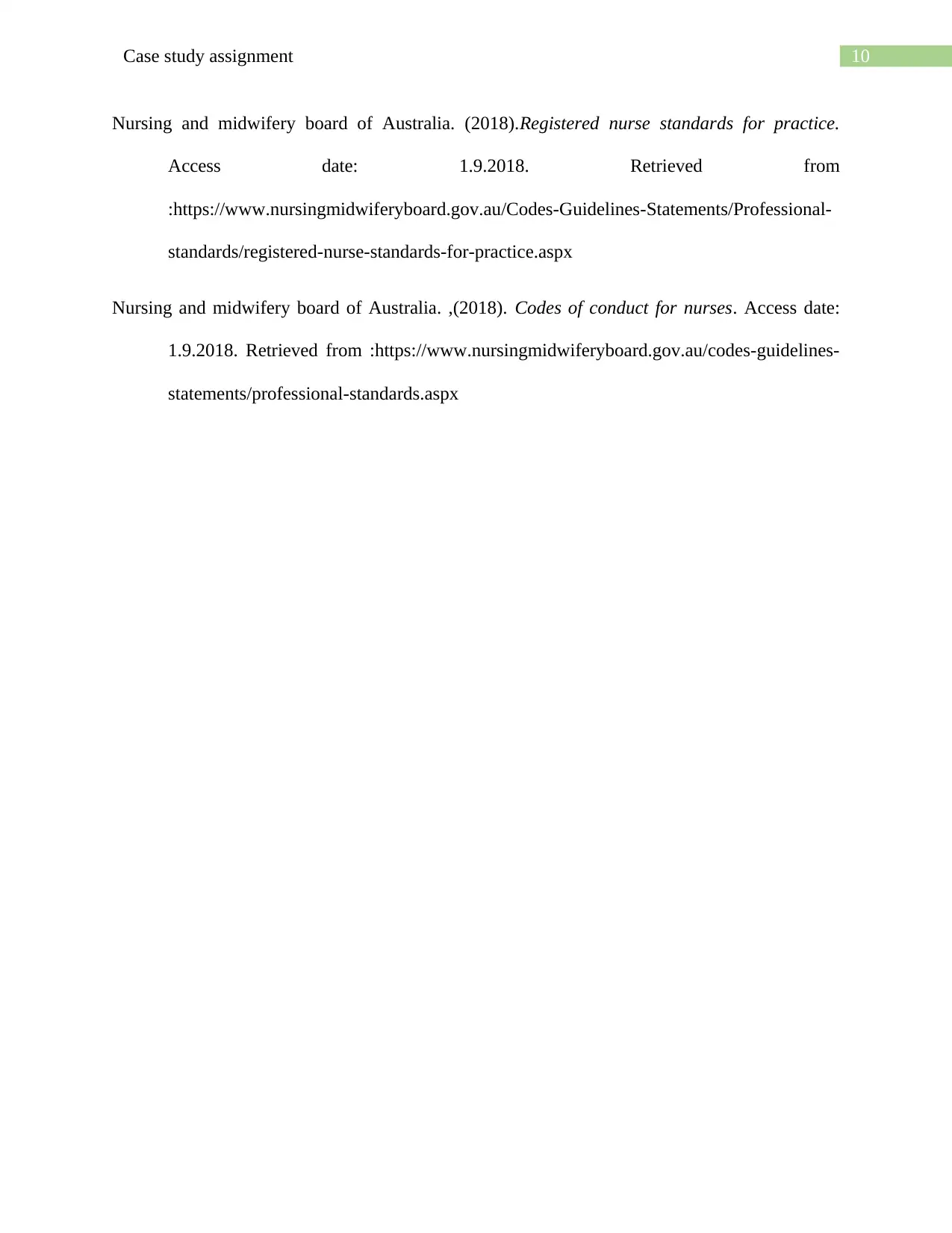
10Case study assignment
Nursing and midwifery board of Australia. (2018).Registered nurse standards for practice.
Access date: 1.9.2018. Retrieved from
:https://www.nursingmidwiferyboard.gov.au/Codes-Guidelines-Statements/Professional-
standards/registered-nurse-standards-for-practice.aspx
Nursing and midwifery board of Australia. ,(2018). Codes of conduct for nurses. Access date:
1.9.2018. Retrieved from :https://www.nursingmidwiferyboard.gov.au/codes-guidelines-
statements/professional-standards.aspx
Nursing and midwifery board of Australia. (2018).Registered nurse standards for practice.
Access date: 1.9.2018. Retrieved from
:https://www.nursingmidwiferyboard.gov.au/Codes-Guidelines-Statements/Professional-
standards/registered-nurse-standards-for-practice.aspx
Nursing and midwifery board of Australia. ,(2018). Codes of conduct for nurses. Access date:
1.9.2018. Retrieved from :https://www.nursingmidwiferyboard.gov.au/codes-guidelines-
statements/professional-standards.aspx
1 out of 11
Related Documents
Your All-in-One AI-Powered Toolkit for Academic Success.
+13062052269
info@desklib.com
Available 24*7 on WhatsApp / Email
![[object Object]](/_next/static/media/star-bottom.7253800d.svg)
Unlock your academic potential
Copyright © 2020–2025 A2Z Services. All Rights Reserved. Developed and managed by ZUCOL.




